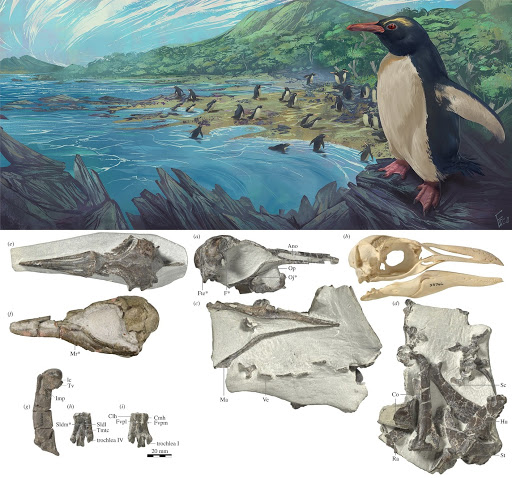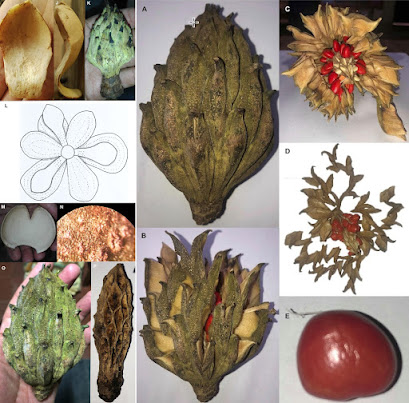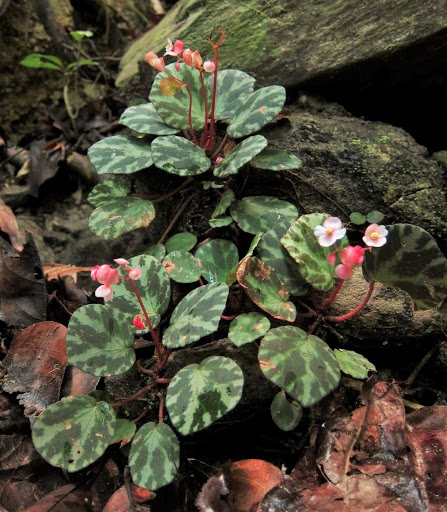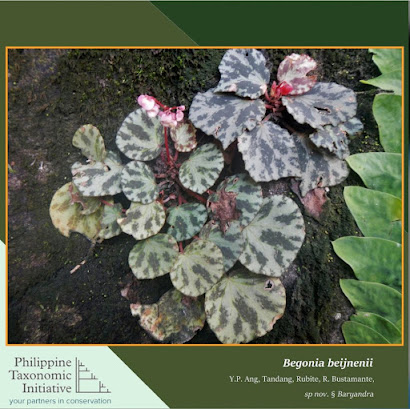[Most Recent Entries] [Calendar View]
Thursday, August 13th, 2020
| Time | Event | ||||
| 2:52a | [PaleoOrnithology • 2020] Eudyptes atatu • Ancient Crested Penguin (Aves, Sphenisciformes) Constrains Timing of Recruitment into Seabird Hotspot
Abstract New Zealand is a globally significant hotspot for seabird diversity, but the sparse fossil record for most seabird lineages has impeded our understanding of how and when this hotspot developed. Here, we describe multiple exceptionally well-preserved specimens of a new species of penguin from tightly dated (3.36–3.06 Ma) Pliocene deposits in New Zealand. Bayesian and parsimony analyses place Eudyptes atatu sp. nov. as the sister species to all extant and recently extinct members of the crested penguin genus Eudyptes. The new species has a markedly more slender upper beak and mandible compared with other Eudyptes penguins. Our combined evidence approach reveals that deep bills evolved in both crested and stiff-tailed penguins (Pygoscelis) during the Pliocene. That deep bills arose so late in the greater than 60 million year evolutionary history of penguins suggests that dietary shifts may have occurred as wind-driven Pliocene upwelling radically restructured southern ocean ecosystems. Ancestral area reconstructions using BioGeoBEARS identify New Zealand as the most likely ancestral area for total-group penguins, crown penguins and crested penguins. Our analyses provide a timeframe for recruitment of crown penguins into the New Zealand avifauna, indicating this process began in the late Neogene and was completed via multiple waves of colonizing lineages. Keywords: New Zealand, Bayesian phylogeny, penguin, Pliocene, Eudyptes, ancestral area Systematic palaeontology Aves Linnaeus, 1758 Sphenisciformes Sharpe, 1891 Spheniscidae Bonaparte, 1831 Eudyptes Vieillot, 1816 Eudyptes atatu sp. nov. Thomas, Tennyson, Scofield and Ksepka. Etymology. From Te reo Māori, ata tū (‘dawn’), referencing the stem position within Eudyptes and the earliest recorded appearance of Eudyptes in New Zealand. Type locality and horizon. Late Pliocene (Piacenzian) Tangahoe Formation in the southern Taranaki region of the North Island of New Zealand. ... Daniel B. Thomas, Alan J. D. Tennyson, R. Paul Scofield, Tracy A. Heath, Walker Pett and Daniel T. Ksepka. 2020. Ancient Crested Penguin Constrains Timing of Recruitment into Seabird Hotspot. Proceedings of the Royal Society B. DOI: 10.1098/rspb.2020.1497 | ||||
| 4:21a | [Botany • 2020] Magnolia ottoi (Magnoliaceae) • A New Species from Purulhá, Baja Verapaz, Guatemala: Conservation and Mayan Q’eqchi ‘ Ethnotaxonomy
Abstract A new species of Magnolia subsect. Talauma (“jomcoj”), Magnolia ottoi, is described and illustrated. The conservation status of this new species is proposed as critically endangered (CR) according to IUCN criteria. An identification key and a map with the distribution of the new species and other species of Magnolia subsect. Talauma from Guatemala and neighboring areas (Honduras and Chiapas, México) is also presented. Our field research also unveiled the Mayan Q’eqchi’ ancestral taxonomic knowledge which differentiates magnolias of two different subsections, Magnolia and Talauma, based on wood quality and properties. They consistently distinguished them as “coj” and “jomcoj” respectively. Keywords: Magnolia subsect. Talauma, Magnolia steyermarkii, Magnolia quetzal, Magnolia ottoi, Magnolia atlantida, Magnolia cochranei, Magnolia lacandonica, Magnolia perezfarrerae, Mayan Q’eqchi’, Magnoliids Magnolia ottoi A. Vázquez, Tribouillier & Archila sp. nov. Type: GUATEMALA. Baja Verapaz: Purulhá. 2 km south of Purulhá, 1600 m, moist-subtropical cloud forest, July 2015 (fl), Otto Alvarado (recorded by Tribouillier & Archila MG-005) (holotype BIGU; Isotype IBUG). Magnolia ottoi is similar in leaf shape to M. steyermarkii but it differs from the latter in the size of its leaves (leaf length to width ratio: 1.83–2.22 vs. 1.50–1.76) and flowers (20.2–22.2 cm vs. 12.0–13.0 cm in diameter) and the number of bracts (2 vs. 1); stamens (102–108 vs. 75–78) and carpels (38–50 vs. 30–32). Also the carpels of M. ottoi are beaked vs. acute in M. steyermarkii Etymology and ethnobotany:— The species epithet honors Otto Alvarado, collector of the species. The ancestral Mayan (Q’eqchi ‘) understanding of Magnoliaceae includes recognizing species of different sections classifying them as Coj (sect. Magnolia) and Jomcoj (sect. Talauma). When visiting one of the ranches one of the companions proceeded to show us two wood planks indicating that the trees of the subsect. Magnolia (Coj) had a high-quality wood, while the trees of the subsect. Talauma (Jomcoj) was considered bad wood for construction because its fibers are not strong enough and it was easily cracked, so they rather use them as firewood for cooking. Distribution and ecology:— Magnolia ottoi is endemic to Purulhá, Baja Verapaz, Guatemala (Fig. 1). Only known from the type locality. Although 5 km from the type locality, in the Biotope of the Quetzal Mario Dary-Rivera, Fredy Archila and Erick Tribouillier observed several juvenile plants of Magnolia, these had very large leaves and possibly correspond to this new species. The only known trees (3) inhabit very humid forests at three different elevations 1550– 1650 m, pp 2284 mm, t 16–230 C; wavy topography. Common species include: Liquidambar styraciflua Linnaeus (1753: 999), Persea donnell-smithii Mez (1892: 113), Pinus pseudostrobus Brongniart (1828: 46), Persea schiedeana Nees von Esenbeck (1836: 130), Rapanea ferruginea (Ruiz López & Pavón 1798: 280) Mez (1901: 429), Clethra spp., Morella cerífera (L.) Small (1903: 337), Eurya seemanniana Pittier (1922: 480), Pouteria viridis (Pittier 1914: 84) Cronquist (1946: 290) and Magnolia archilana A.Vázquez, Tribouill. & Véliz in Vázquez-García et al. (2019: 222). Flowering in March, and fruiting from March to April.
J. Antonio Vázquez-García, Erick Tribouillier-Navas, Fredy Archila and Mario Esteban Véliz-Pérez. 2020. Magnolia ottoi (Magnoliaceae) A New Species from Purulhá, Baja Verapaz, Guatemala: Conservation and Mayan Q’eqchi ‘ Ethnotaxonomy. Phytotaxa. 455(3); 187–195. DOI: 10.11646/phytotaxa.455.3.1 | ||||
| 4:34a | [Botany • 2020] Begonia beijnenii (Begoniaceae, section Baryandra) • A New Species of Begonia from San Vicente, Palawan, the Philippines
Abstract In our study, a distinctive new species of Begonia from an unexplored region of Port Barton, San Vicente, Palawan, Begonia beijnenii, is described and illustrated. The new species belongs to section Baryandra. It is morphologically most similar to B. hughesii, in having a 3-winged ovary with a cucullate wing and an abortive abaxial locule, tomentose petioles, and leaves that are adaxially glabrous and abaxially subglabrous. However, B. beijnenii distinctly differs by being comparatively smaller in size. It is only known from its type locality and vicinity. Comparisons with two variegated species of Palawan: B. cleopatrae and B. gironellae are also provided to aid in identification. B. beijnenii is hereby proposed to be Vulnerable (VU) D1, based on guidelines by IUCN. Keywords: Begonia cleopatrae, Begonia gironellae, Begonia hughesii, endemic, Eudicots, Malesia, taxonomy Yu Pin Ang, Danilo N. Tandang, Rosario R. Rubite and Rene Alfred Anton Baena Bustamante. 2020. Begonia beijnenii (Begoniaceae, section Baryandra), A New Species of Begonia from San Vicente, Palawan, the Philippines. Phytotaxa. 455(3); 196–204. DOI: 10.11646/phytotaxa.455.3.2 |
| << Previous Day |
2020/08/13 [Calendar] |
Next Day >> |












